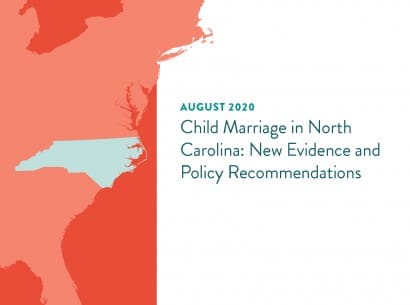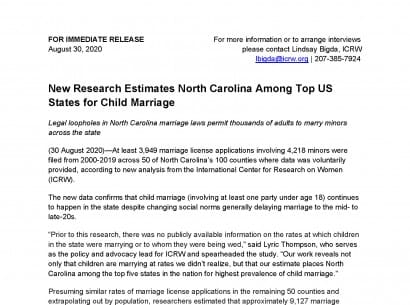
Child Marriage in the United States: A Synthesis of Evidence on the Prevalence & Impact
 The most comprehensive effort to date to estimate the rates of child marriage in the United States (U.S.) was conducted by the Public Broadcasting System (PBS) for their Frontline documentary series on child marriage in America, which found that at least 207,459 children below the age of 18, most of them girls, were married in the U.S. between 2000 and 2015 (Tsui, Nolan, & Amico, 2017). However, the reporters were unable to obtain data from six states and the District of Columbia and only obtained data from certain counties in three additional states, meaning that this total also underestimates the true prevalence of child marriage in the United States (Tsui et al., 2017). Despite the limitations of the data available, what is certain is that child marriage is happening in the U.S. at rates that merit further attention and scrutiny.
The most comprehensive effort to date to estimate the rates of child marriage in the United States (U.S.) was conducted by the Public Broadcasting System (PBS) for their Frontline documentary series on child marriage in America, which found that at least 207,459 children below the age of 18, most of them girls, were married in the U.S. between 2000 and 2015 (Tsui, Nolan, & Amico, 2017). However, the reporters were unable to obtain data from six states and the District of Columbia and only obtained data from certain counties in three additional states, meaning that this total also underestimates the true prevalence of child marriage in the United States (Tsui et al., 2017). Despite the limitations of the data available, what is certain is that child marriage is happening in the U.S. at rates that merit further attention and scrutiny.
IMPACTS OF CHILD MARRIAGE IN THE U.S.
The research on age at marriage in the United States shows that marrying early has universally detrimental effects over a range of outcomes. In this report, we take a deeper look at:
- educational attainment,
- earnings,
- physical, reproductive, and mental health,
- experiences of violence, and
- likelihood of divorce.
While delving into available research on the impacts of child marriage in the country, we found two major gaps. First, we were unable to locate any research that studied the impacts of age of marriage on outcomes for same-sex couples. While the proportion of same-sex couples that marry when one or both partners is below age 18 is probably quite small, there should be sufficient data at this point to begin looking at overall trends in age of marriage and related outcomes. Second, the research on the impacts of child marriage has typically focused on girls, as girls make up the majority of children married below the age of 18 in the U.S. and globally. However, the research that has included men and boys in the U.S. has shown smaller or nonsignificant effects on future earnings or physical health, indicating that outcomes for boys cannot be inferred to be the same as outcomes for girls and are therefore worthy of further study.
All that said, perhaps the most important aim of future research should be the exploration of causes of and mechanisms to prevent child marriage in the U.S.

IMPLICATIONS FOR POLICY:
Child marriage, wherever it occurs, should be addressed in ways which do not undermine other rights or leave behind those adolescents who have already been married. ICRW’s global research has shown the following five strategies to be effective in the delay or prevention of child marriage:
- Empower girls with information, skills and support networks;
- Provide economic support and incentives to girls and their families;
- Educate and rally parents and community members;
- Enhance girls’ access to a high-quality education; and
- Encourage supportive laws and policies to end child marriage and meet the needs of married children.
The U.S. should be no exception. Policies at the state or federal level should endeavor to make 18 the minimum age of marriage, with no exceptions, and to meet the needs of married adolescents who are at higher risk of violence and a number of deleterious health, education and economic impacts once married.
EVENT
M. Steinhaus and Thompson, L. (2020). No Exceptions: A Synthesis of Evidence on the Prevalence and Impact of Child and Early Marriage in the United States and How This Compares to Existing Global Evidence. Washington, DC: International Center for Research on Women.
© 2020 International Center for Research on Women


